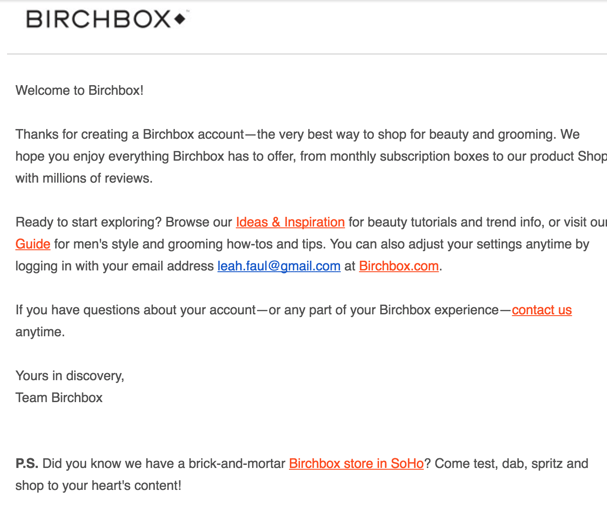One of the best marketing tools could be right under your nose, and you don't even know it.
Transactional emails - that’s right, those seemingly innocuous system-triggered emails based on a specific user’s activity are all the rage right now. These little gems are now being featured in case studies, how-to blogs, and top 10 lists.
What's best? They convert like crazy, when done right.
It makes perfect sense if you think about it. Psychologically, transactional emails offer an incredible conversion opportunity to marketers.
“Transactional emails are more personal, and they’re highly anticipated, which leads to improved deliverability and increased engagement” (ConversionXL).
Simply put, transactional emails are tailored to your experience as a consumer and they sport an 8x higher open rate than all other emails.
These secret weapons have not traditionally been on the marketing professional’s radar for optimization and consideration. Typically, because IT/billing has generally controlled these emails apart from the marketing team.
Until now.
Some companies like Kickstarter, Skillshare, and Drift are getting it right, though. Drift actually sent an email promoting an article about their highly recognized transactional emails.

It goes without saying that the above companies are unicorns. They strive to optimize every single customer touchpoint. From these companies, we learn about hyper-personalization, triggers, and now tactics like amplifying conversions through transactional emails.
Though we have featured SaaS companies, this practice can be just as effective for traditional industries and brick-and-mortar businesses. Transactions happen at these companies, so there is just as much opportunity for a service-based or local business to use this strategy as well.
Email marketers are told always to remain aware of how many emails you are sending and not overwhelm your lead's inbox. So, transactional emails are the best solution in this situation.
They are being sent anyway. Why not use them?
When used properly, transactional emails can:
- Maximize profits
- Increase social engagement
- Heighten social proof
- Offer new conversion paths to already paying customers
Best Practices for Transactional Email
Would you try to remove someone's appendix without going to medical school? (If you said yes to this question, conversion rates are the least of your worries)
You need to understand how surgery works before doing it.
It's also important to understand how transactional emails work before trying to operate on them. (Okay, it's not the same as some psycho performing surgery, but it's still important.)
Let's break down the who, what, when, where, and why of transactional emails. This is important because every transactional email is a marketing opportunity.
The 4 Types of Transactional Emails
1. Welcome Emails
As your first method of contact with the consumer, the welcome email should provide helpful resources, prove the worth of the product or service, and bring them closer to the next stage of the funnel (probably the monetization funnel).
Birchbox does a phenomenal job with their welcome email. See the “P.S.” at the bottom?

This is a monthly subscription welcome email. They use this marketing real estate to entice you into their brick-and-mortar store to sniff, play, and ultimately spend even more.
2. Confirmation Emails
Following a purchase or an update to account information, most users receive confirmation emails. The traditional purpose of this email was to send a receipt, and generally confirm the action a user took was successful.
Here's an example of an optimized confirmation email from the Dollar Shave Club. Notice how they use the available real estate in this email to dangle additional products for an easy upsell.

3. Reminder/Notification Emails
Reminder/notification emails are important for billing, deadlines, and other types of notifications. They should be short and sweet, request an action, and be consistent without being invasive.
For maximizing profit use the “abandoned cart” reminder here if it fits your business model.
Here’s a Fab-ulous example of one of these highly effective sales-boosting transactional emails.

4. Request Emails
Request emails add value in intangible, yet effective, ways. You've seen these dozens of times whether you realize it or not.
It looks like this: A few days after making a purchase, you receive an email asking for feedback. You remember the product and if the stars align (timing, content, product or service quality), you take action and give them what they want. Sometimes, it's a request to fill out a quick survey about your experience and the product quality, other times it is a request to tweet or share your experience with others.
Think about this in terms of your website content. If you get phenomenal reviews as feedback, you can add them in as case studies or testimonials.
It adds wonderful elements of social proof!
2. Optimize for Mobile
Almost half of all emails are opened on mobile devices, making it imperative to understand (if you don’t already) how to craft an email that looks clean and is easy to read on any screen size.
If you neglect this simple step, you may find that your customers become irritated by having to scroll over and maximize/minimize images, links, and buttons. In fact, they just won't do it. So, your conversions and customer engagement will be the real casualties.
Test all transactional emails on your mobile device and use responsive email templates to ensure you are not losing conversions simply because of a poor mobile design.
3. Provide Helpful Resources
Always make recommendations that enhance your customer’s experience. Following up with helpful suggestions all but guarantees they will be more open to future purchases and sharing your message on social channels.
For example, Netflix does a great job of suggesting shows based on recent viewing. They send notifications through email when something becomes available in which you’ve expressed interest. If you are a clothing company, and an individual buys a specific type of clothing, don't hesitate to showcase similar items in your transactional emails.
One small warning here: Make sure you don’t crowd your target with too much “noise.”
This is a proven and effective opportunity to add value and monetize transactional emails, but it can easily lead to the dreaded unsubscribe if abused.
4. Ask for Referrals
After your consumer has completed a transaction, go ahead and ask for a referral. It’s a great time, since the interaction is fresh on their mind and they are more likely to have a positive attitude already.
Referral Rock is a great place to start if you are looking for an app or service to help make this a more manageable aspect of your marketing strategy.
5. Create a Seamless Experience
Make it easy for the consumer to provide feedback and contact you if need be. Provide links, and never send messages through an email address that doesn’t allow them to email you back.
Really, can we just end the no-reply@ihatethiscompany.com?
This is frustrating for your clients, and seems, frankly, as if you don’t care. Plus you might miss a sale that would have gone through if the customer had been able to ask a quick question.
6. Understand Timing and Use it to Your Advantage
Marketing emails should be sent at a time when they’re most likely to be read… Duh.
When exactly would that be?
Monday through Friday during business hours?
Weekends?
Research is all over the board. So the answer is, know your clients. Play around with delivery times and don’t be afraid to stick out like a sore thumb.
Often, doing whatever sets you apart is best. Neil Patel, for example, sends his marketing emails at 10 AM on Sunday.
Every Sunday.
That’s different, but it stands out.
7. Tactful and Segmented Upsell Offers
Tread carefully here, so you don’t flood your consumer with offers and come off like you're a used car salesman. (No offense to all the honest used car salesmen that read this. I just don't doing business with you. Can we still be friends?)
For many companies, a sale could quickly equal another sale - or an investment in a consultation, training, and the like.
For example, let’s say you are selling firewall software for IT professionals. The transactional email confirming a purchase could politely suggest another software they will likely need. If there is no additional product, you might invite them to enroll in a course to help them effectively implement their new software. This both shows that you genuinely wish to help them and opens the door for another sale.
Looking Toward the Future
64% of consumers say transactional emails are the most valuable emails they get.
What’s more, the average revenue for these emails is up to six times greater than the standard bulk mail.
Intriguing, right?
Feel free to use these tips we’ve discussed to craft transactional emails for your company. You may find they become an indispensable part of your business.
We believe this often-overlooked avenue is one of the great marketing strategies of the future. After all, transactional emails probably already play a huge role in your company’s sales process. Why not make them work for you and sell more?
Anything we missed? We would love to hear your thoughts and tips on transactional emails.





